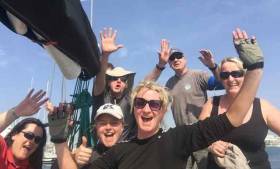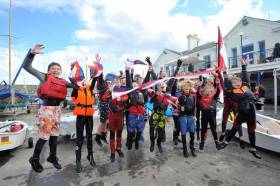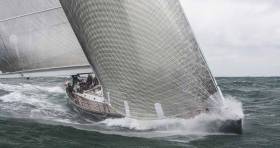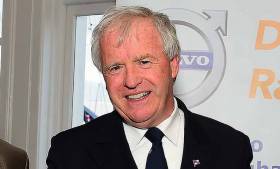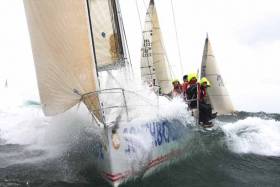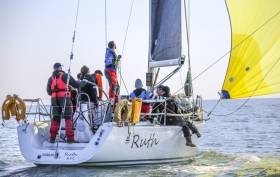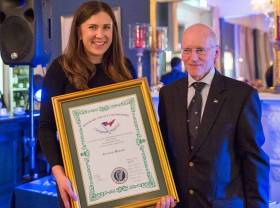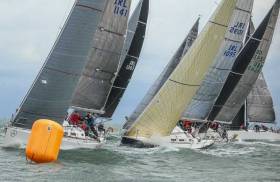Displaying items by tag: National Yacht Club
ISORA Yacht Scores in Spanish Offshore 'Salt Race', NYC Adelie Crew Celebrate in Ibiza
After a very successful tenth ISORA season last year, offshore campaigner Peter Hall from the National Yacht Club in Dun Laoghaire decided to relocate his Beneteau First 34.7 and try his hand in warmer climes! Adélie went south last autumn and is now based in Ibiza, and this was the first race of his season.
It is the 30th anniversary of the Ruta de la Sal regatta (Salt Race) and the first time they've had a Salina class in the race - for boats skippered by a female (Mairead Ni Cheallachain in the case of Adelie pictured below with trophy) and with at least 50% female crew (Adelie had Antonia O'Rourke, Louise Dwyer, Susan Delaney, Noel Butler and Sam Hunt as well as Peter and Ni Cheallachain). It's an initiative by the Spanish to try and encourage more female participation in offshore racing. There were seven boats entered in the Salina class (2 x First 40.7, X302, Oceanis 43, Bavaria 50, Sunfast 32 - all Spanish boats).
92 boats overall raced from Denia on the mainland, south around Formentera and then north around the Ibiza coast to a finish in San Antonio, Ibiza - a course of roughly 125nm.

The race took just over 26 hours in starting in beautiful moderate champagne sailing conditions, which overnight fell to very light, leading to some very tactical, technical racing!
In the overall fleet Adelie came 13th of 92 - in her racing class A3 they came 6th of 20 and won the Salina class ahead of the two local 40.7s
Results are here
National Yacht Club Junior Sailors Celebrate Links to Olympic Silver Medal & America’s Cup
A very special Golden Jubilee coming up in May provides links to an Irish Olympic Sailing Silver Medal, the Fireball World Championship, and the America’s Cup. W M Nixon finds the widest connections go even further than that to include a pioneering world voyage.
It was in May 1967 that the irrepressible Carmel Winkelmann oversaw the first results of a junior sailing initiative at the National Yacht Cub, her home club in Dun Laoghaire. It became a movement which went on which to have nationwide and worldwide ramifications, so much so that within Ireland we’re looking at an unbroken line in Irish sailing which is continued through the club which currently holds the title of ISA Training Centre of the Year, which for 2017 is Foynes Yacht Club on the Shannon Estuary.
That a successful club at the heart of the Atlantic seaboard can trace an almost magic thread back to something which happened at a club on Dublin Bay a long time ago is quite a story in itself. Particularly when the Atlantic seaboard club itself is imbued, as Foynes is, with the spirit of legendary circumnavigator Conor O’Brien. However, when the story is shaping up to continue with the Golden Jubilee as the latest chapter, it gives us an opportunity both to celebrate, and take stock of what it has all meant.
 Foynes Yacht Club, heirs to an Irish tradition of junior sail training which was first formalized by the National Yacht Club 50 years ago. At the Irish Sailing Awards ceremony when Foynes were announced as winners of the ISA Training Centre of the Year Award were (left to right) Simon McGibney (Foynes Senior Instructor), Sailor of the year and Olympic Silver Medallist Annalise Murphy of the National Yacht Club, Elaine O’Mahoney (Foynes Sailing Academy Manager), Pat Finucane (Sailing Academy Principal) and Conor Dillon (Instructor). In a club which is imbued with the spirit of world-girdling Foynes sailor Conor O’Brien, it’s particularly appropriate that Conor Dillon’s sailing CV includes winning the Two-Handed division in the Round Ireland Race, sailing with his father Derek Dillon on a 34-footer. Photo: Inpho
Foynes Yacht Club, heirs to an Irish tradition of junior sail training which was first formalized by the National Yacht Club 50 years ago. At the Irish Sailing Awards ceremony when Foynes were announced as winners of the ISA Training Centre of the Year Award were (left to right) Simon McGibney (Foynes Senior Instructor), Sailor of the year and Olympic Silver Medallist Annalise Murphy of the National Yacht Club, Elaine O’Mahoney (Foynes Sailing Academy Manager), Pat Finucane (Sailing Academy Principal) and Conor Dillon (Instructor). In a club which is imbued with the spirit of world-girdling Foynes sailor Conor O’Brien, it’s particularly appropriate that Conor Dillon’s sailing CV includes winning the Two-Handed division in the Round Ireland Race, sailing with his father Derek Dillon on a 34-footer. Photo: Inpho
But business first. Anyone who has ever taken part in the Junior Training Programme at the National Yacht Club is hereby alerted – if you don’t know already – that on the evening and night of Saturday May 20th, there will be a very special celebration at the clubhouse. The organisers Carmel Winkelmann and Ann Kirwan are particularly keen to trace those who have moved away, but would find much nostalgic pleasure with the meeting of old friends by returning on this day of days. So if that applies to you, or you know anyone to whom it does, please make contact with the key club administrator whom everyone refers to as “Oonagh at the National”, the proper line of contact being [email protected], tel 01-280 5725.
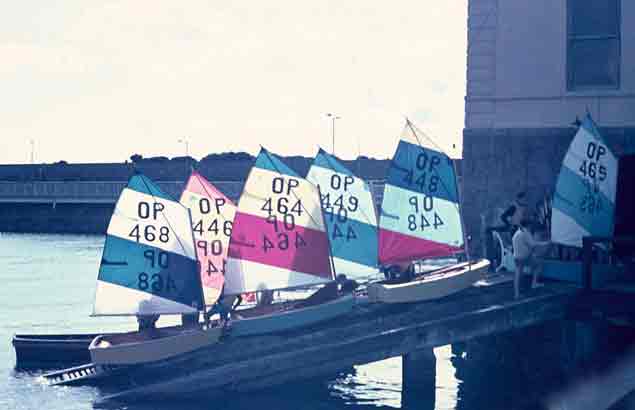 Bright morning of Optimism. The National Yacht Club slipway in 1967, long before the days of an extensive front-of-club platform, with the new dinghies of the Optimist Class being launched out of the cramped boathouse under the club, and down a steep and often very crowded slipway
Bright morning of Optimism. The National Yacht Club slipway in 1967, long before the days of an extensive front-of-club platform, with the new dinghies of the Optimist Class being launched out of the cramped boathouse under the club, and down a steep and often very crowded slipway
To grasp the significance of what is being celebrated, please try to visualize the National Yacht Club as it was fifty years ago. The building itself, standing directly in the harbour, has the air of a fishing lodge in the West of Ireland on its seaward side, and a hint of neo-classicism when seen from the town. But in the early 1960s it was very limited in its shoreside facilites for sailing dinghies. There was a boathouse entered through fine granite arches under the clubhouse itself, but to use it, masts needed to be lowered. It was served by a very steep and easily-crowded slip, while there was access to another slip on the east side of the cub which served a small area where dinghies could be stored. But while there was space for the established classes of Fireflies and some IDRA 14s, some room was also needed for the small tenders for larger yachts moored in the harbour, while the racing keelboats were served by club launches which might be substantial dinghies driven by vintage Seagull outboards.
The concept of a proper dinghy park was still only in its infancy, relatively speaking, for craft such as Dun Laoghaire’s Firefly and IDRA fleets which had been active since the late 1940s. Thus if anyone had a centreboard boat which could reasonably be expected to lie to moorings, she was obliged to do so, and the fleet of small craft lying off the club included the 17ft Mermaids and the 14ft Water Wags.
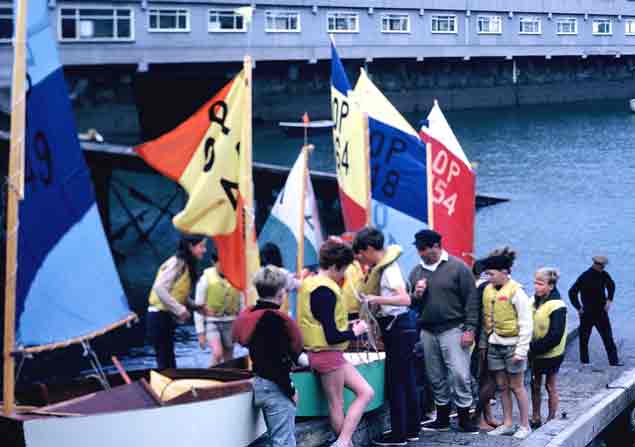 It could get very crowded on that steep slipway. Paddy Kirwan at the centre of a group making do with limited facilities
It could get very crowded on that steep slipway. Paddy Kirwan at the centre of a group making do with limited facilities
To compound the space problems afloat and ashore, during the 1960s the area in the southeast part of Dun Laoghaire Harbour off the National Yacht Club was the focal point for the cross-channel ferry berths. The railway-system serving Mailboat with its emphasis on foot passengers continued to use the Carlisle Pier to the west of the club, but the East Pier was known for a period as the Car Ferry Pier as a busy new roll-on roll-off terminal, which admittedly always had a temporary look about it, had been constructed there to accommodate the new trend in cross-channel travel.
Thus not only was anyone sailing a dinghy from shore at the National YC dong so out of decidedly limited facilities, but they immediately sailed into an area cluttered with a collection of moored boats of all shapes and sizes, and that in turn was set in an area which might have ferry ships berthed close by, or manoeuvring on either side.
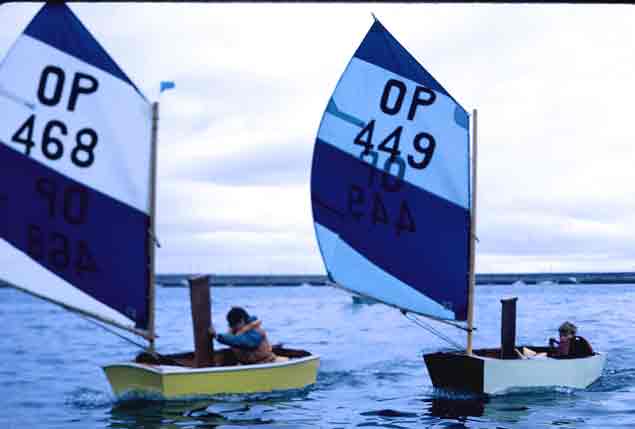 Learning curve. Gina Duffy and John Lavery on a close run in 1967. The latter has won many major championships, including the Fireball Worlds in 1995
Learning curve. Gina Duffy and John Lavery on a close run in 1967. The latter has won many major championships, including the Fireball Worlds in 1995
The comparisons with today’s National Yacht Club with its spacious platform facing out over a much clearer harbour area, and beside it an installation of convenient berthing pontoons, could not be greater. But back in the 1960s, an equally important change was happening – there was a complete re-appraisal of what the most junior sailors really needed in boats and instruction to get the best from the sport.
For sure there were the Fireflies, but in terms of lower age limit they were really aimed at adolescents on the cusp of rapidly growing youth. The other available classes were even more adult-oriented. In fact, the underlying problem was that children going sailing were treated as miniature adults who would somehow pick up the skills of the game through a sort of osmosis, whereas for a crucial period of their lives they would have most benefitted from being treated as a different species, with different boats to meet their needs.
Yet even here, adult views dominated. The grown-ups thought that young people’s boats should at least look like small yachts. Thus a dinghy which was promoted for children by several clubs was the 11ft Yachting World Cartop Heron, which had originally been conceived as a DIY-build which could fit on the roof-rack of the average family car, and was designed with a gunter rig such that all its spars could be stowed within the boat.
It had some good ideas, and with a pretty sheer it fulfilled the adult expectation of what a miniature yacht should look like. But it was surprisingly heavy for its avowed rooftop requirement – you’d have needed a weight-trained family to get it on the car roof. And anyway, it was too large for really small kids who genuinely had the sailing bug.
 The southeast corner of Dun Laoghaire Harbour was very different in 1967, with the East Pier re-designated as the Car Ferry Pier. Yet despite the limitations, the Optimist class quickly caught on after its introduction in 1967
The southeast corner of Dun Laoghaire Harbour was very different in 1967, with the East Pier re-designated as the Car Ferry Pier. Yet despite the limitations, the Optimist class quickly caught on after its introduction in 1967
So a revolutionary approach was needed, and it came thanks to one of the National YC’s international sailing stars, Johnny Hooper. He had achieved Ireland’s first Olympic Race win with Peter Gray in the Flying Dutchman in the 1960 Rome Olympics when the sailing was at Naples. But as an FD campaign towards the 1984 Olympics was prohibitively expensive with the venue in Japan, he returned to his first love of International 505 Racing, and it was at a big 505 championship in Scandinavia in 1965 or thereabouts that he first became aware of the game-changing possibilities of the Optimist for junior sailing.
Scandinavia being rightly renowned for the elegance of its yacht, it speaks volume for the versatility of the Florida-originating Optimist, the “simple little boxboat that sails surprisingly well”, that Scandinavia should lead the movement towards a world body for a boat which, whatever the traditionalists might think, the kids were clearly loving. Founded 1965, the International Optimist Dinghy Association (IODA) had Viggo Jacobsen of Denmark as its first President with his wife Edith as Secretary, and in that same year Johnny Hooper set about introducing the idea of the Optimist to Ireland.
Now if some ordinary Joe had happened to by impressed by an Optimist at some foreign location, and had even brought one home to persuade his fellow sailors that they were looking at the future, the idea probably would have fallen very flat indeed.
But that’s not the Hooper way. Instead, from his highly respected position he quietly targeted fellow National Yacht Club members who were themselves active sailors, but also had children who would benefit from the Optimist experience, and in time a group emerged which was to include initially Johnny Hooper with his wife Bernie giving the longterm involvement, Peter Gray, Paddy & Barbara Kirwan , Don Douglas, Franz & Carmel Winkelmann, Michael McGrath, Arthur Lavery and several others, many of whom had reasonable DIY skills and could see the possibility of building an Optimist in the basement of their Dun Laoghaire homes without too much disruption of the household. By the Autumn of 1966, the project was under way.
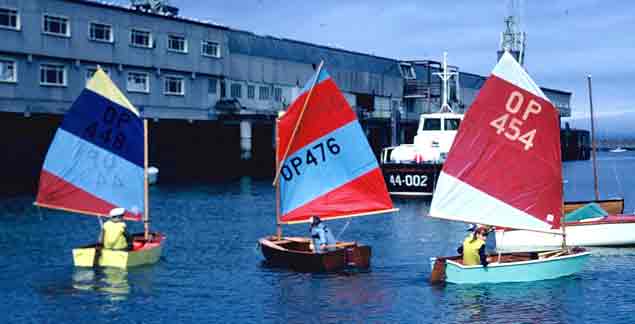 The first of the new fleet sails. Paddy Boyd (left) Ann Kirwan (centre) and Vivienne Lavery right) getting to know their boats
The first of the new fleet sails. Paddy Boyd (left) Ann Kirwan (centre) and Vivienne Lavery right) getting to know their boats
While Johnny Hooper had introduced the idea, he stood back from its continuing implementation, for the Hooper modus operandi was to give an idea enough strength to soon have wings of its own. That certainly happened in the National Yacht Club, for very quickly a manageably small committee was in being, and the formidable Carmel Winkelmann became its secretary. The NYC Junior Programme became her baby, and it always has since been seen as such, even though the number of people involved in administering the programme over the fifty years, as the NYC facilities have expanded and developed to meet the needs of a modern membership, will now run into the hundreds.
In fact, properly organized junior sailing with boats specifically designed for young people’s needs is now so central to Irish sailing that it takes a huge leap of the imagination to visualize the scene as the first small group of National Yacht Club Optimist Dinghies – most of them locally-built either by amateurs or professonals – began to emerge in May 1967 with numbers increasing as each weekend passed. New they may have been, but they reflected their era, with a public Blessing of the Boats outside the Brindley household as a new batch of boats appeared.
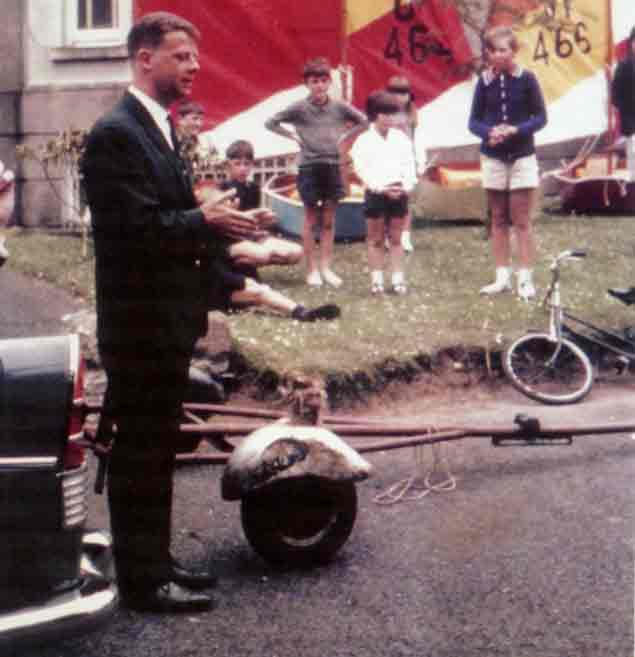 Olympic sailor Johnny Hooper speaking at the Blessing of the Boats as a new batch of home-built Optimists awaits transfer to the National’s limited space.
Olympic sailor Johnny Hooper speaking at the Blessing of the Boats as a new batch of home-built Optimists awaits transfer to the National’s limited space.
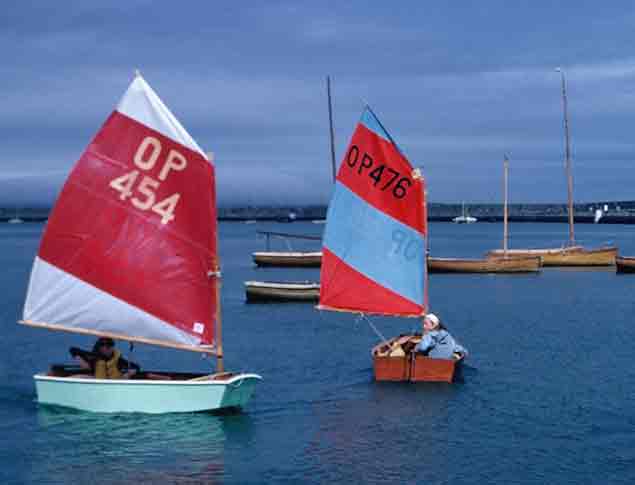 Dun Laoghaire was a different place in those days, with Water Wags and Mermaids expected to lie to mooring. Vivienne Lavery and Ann Kirwan testing their skills with the new Optimists – Ann’s boat (476) was one of the few professionally-built in the first batch of Optimists, she was created by the legendary Skee Gray
Dun Laoghaire was a different place in those days, with Water Wags and Mermaids expected to lie to mooring. Vivienne Lavery and Ann Kirwan testing their skills with the new Optimists – Ann’s boat (476) was one of the few professionally-built in the first batch of Optimists, she was created by the legendary Skee Gray
But though most young sailors in theory had his or her own boat, before anything approaching full fleet numbers was approached they’d a habit of letting anyone sail some boat or other in the early stages, so much so that although Ann Kirwan was part of it from a very early stage, she admits that even she can’t claim total accuracy when identifying the helm of a known boat.
 Going abroad......the new Dun Laoghaire Optimists make their debut at Bray Regatta: Paul, Adam and Lucy Winkelmann with Paddy Kirwan putting in his renowned act as a South American Air Marshall at Bray Sailing Club.
Going abroad......the new Dun Laoghaire Optimists make their debut at Bray Regatta: Paul, Adam and Lucy Winkelmann with Paddy Kirwan putting in his renowned act as a South American Air Marshall at Bray Sailing Club.
This habit of inter-changing sailors became even more marked in that first year when the early class discovered that the most useful base for their day-time sailing was the little-used Irish Lights service barge moored in the western part of the harbour. Over there, NYC Optimist sailors found much clearer sailing water, and they were well away from the comings and goings of the two cross-channel ferries off their home club, not to mention excessive parental control. In effect, the barge became their day-time base, and they ate their packed lunches aboard it while deciding who would take which boat for the first stage of the afternoon’s sailing. Fifty years down the line, we might well wonder if the Commissioners of Irish Lights are aware of the key role their humble barge played in launching Ireland’s Junior Training Programme.....
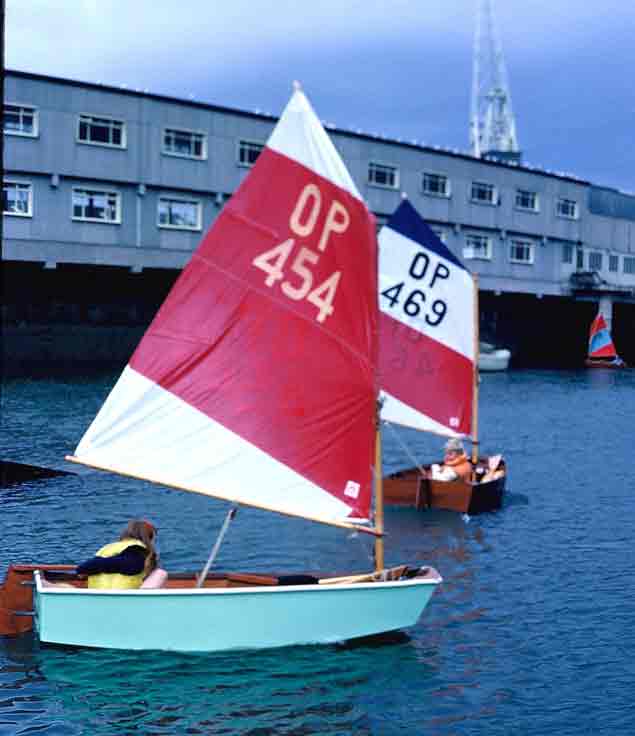 Vivienne Lavery and David Ryan getting away from the slip.
Vivienne Lavery and David Ryan getting away from the slip.
Once launched in its viable form in 1967, there was no stopping it, and the names which have emerged just from the National’s junior programme alone (for virtually all clubs now have one) take us over an extraordinary range, and up to the heights of Olympic participation, the winning of major world dinghy championships and associations with the America’s Cup.
It’s Johnny Smullen who provides the latter. The California-based Johnny Smullen in San Diego is now of world stature in anything to do with yacht and boat-building or indeed in marine construction generally, and his talent has been recognized at the highest level as he has worked on major projects for the very demanding Dennis Conner, aka Mr America’s Cup.
Johnny will have inherited his feeling for classics from his father Cass, a great sailor who was such an enthusiast for the Dublin Bay 21s in their original rather spectacular gaff-rigged form that when the class contemplated changing to a more easily-handled and convenient Bermudan rig in 1963, Cass claimed that he could easily rig a gaff-rigged DB 21 in 15 minutes flat. And that included setting the jackyard topsail to perfection. So he brought a DB 21 close into the clubhouse (as you could in those days), and in front of a drink-sipping crowd of observers on the verandah, he did the job within 15 minutes. But they still went ahead and converted to Bermudan rig.
Son Johnny meanwhile was enlisted in the NYC Junior Programme as soon as he reached he lower age limit, and when the 40th Anniversary was being celebrated back in 2007, he sent on his memoirs which well capture the flavour of it all:
San Diego, 17th May 2007
The way I saw it.
I am eight years old and my parents are wondering what to do with me for the summer, it went something like this: “Get him out from under our feet”. I was equally happy to stay at home and play in the back garden, invent stuff and dream up ways to frighten my sisters. Chasing them with worms was a good one.
I was enrolled in the adventure of my life.
At first I was lead to believe it was going to be a fun thing with the opportunity to meet new people and friends, maybe making me more sociable as I was quiet child in a world of my own. I bought into this and showed up for the first day. It was great, lots of people all different shapes and sizes, so there we were all sitting around playing with stuff and one-upping on how my father is better than yours, especially at snooker. The chatter fell silent when along came this very tall white-haired lady with an incredibly loud voice. It was at this point I became suspicious as I had just watched Paths of Glory and A Bridge Too Far, I had seen how the enemy rounded up people and put them in trucks and brought to places, unfriendly places.....
We arrived at Sandycove harbour where we were lined up on the pier. I though this was it, we were then forced to line up at the steps and walk down into the freezing water fully clothed and flail around, there were guards (instructors we were led to believe) everywhere, and just to make sure the torture was effective they made us hold our heads under water for 30 minutes, well 30 seconds, but it felt like minutes. Then we were all forced to walk back to the NYC where our fate was to be determined. Freezing and scared, I was cursing my family and wondering what I had done to them.
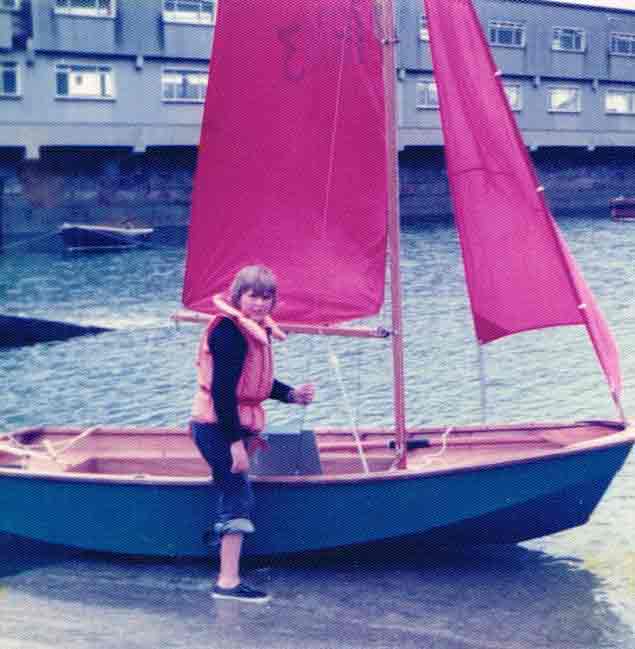 He survived.....eventually Johnny Smullen became a keen Mirror dinghy sailor, but he was pessimistic enough to call his boat Splinter
He survived.....eventually Johnny Smullen became a keen Mirror dinghy sailor, but he was pessimistic enough to call his boat Splinter
We arrived back at Camp NYC and were lined up and made to wear large cumbersome protective coats, some were yellow, purple, some orange, I guessed they were labelling us, something to do with our religion. Some of these jackets had large protective collars probably to help protect us from the beatings to come, I thought. Our names were branded onto the “Life Jackets” as I started to call them, knowing they would play a key role in our protection.
We were divided into groups and lead away by the guards into this large damp room with arches and a dank smell of cotton, hemp and mould. This was where we were to remain for all the rainy days to be brain-washed, they started by teaching us knots. I was convinced this was going to be how to tie the very knot that would be the doom of us, I compared it to carrying the cross of Calvary. I decided then to be really bad at it in the hopes that one of my knots would slip open and I could dash to my freedom. We also had to jump up, and hand-over-hand along the light blue steel beam that ran across the dark room, this was to make our arms really strong, they had a plan for strong arms – I will tell you about that a little later.
Food consisted of a march up to Wimpeys for a spice burger and chips all drowned in vinegar to disguise the taste, if there was good behaviour we got to go to the Miami Café. The day was long (except Thursdays when we had to get out early) and after a week in Boot Camp we were all tired and weary. What had I done to my family to deserve this?
The second week came along and we were introduced to the ships, rather large wooden craft resembling a landing craft with the flat bow (I was always looking for the hinges). This is where the strong arms came into. We were grouped into six per team, and the guards waited until low tide when we had to carry the ship down a rickety wooden slip (there’s a reason for calling it a slip). Upon its surface there were large wooden rollers but we were forbidden to use those rollers, and to make sure they filed a fat spot on the rollers, deeming them useless. We picked up the incredible heavy boat, all six of us, one on each corner holding a knee, and two in the middle by the oar locks. Later I was to learn the place to be was up at the bow (by the door), it was lightest. I was adapting to this cruel camp. As we descended down to the icy water again fully clothed, we came across a bright green pungent slime. I had what I thought were special sailing shoes, but as soon as I touched the slime I was down. Down hard. The guards started yelling, I knew I had to get up quickly....remember Calvary!....We reached the bottom and stopped, the guards yelled again and made us wade right into the icy deep, still fully clothed. With the landing craft now floating, we had to master manoeuvring, the craft were lined up alongside the slippy slip, that’s the reason they call it a..................
I stepped on the gunwhale. Now at this point I did not understand the physics like I do today, and when you apply a load to any point of the gunwhale of a flat-bottomed craft two things will happen (once only). The opposing gunwhale will come up as you travel down, and because I am as tall as the craft is wide, somewhere in the middle he two surfaces will meet, your face and the opposing gunwhale. After the initial shock, the second shock comes from the icy cold water. Then I found out what the large collar was for as the guards hauled me out of the abyss semi-conscious. Once inside the craft, we were grouped into two and handed oars. Let the games begin.....
After a week of rowing and shipping oars and coming alongside we were all adapting well to boating, there’s nothing to it. Just as we are enjoying ourselves, we are reminded that this is a work camp with launch and retrieval exercise twice a day. The launch and retrieval is carefully timed at 6 and 12 hours intervals to make sure it was low tide and we’d the longest slimiest walk up the rickety slips, observed closely by the guards from the window of the snooker room glaring down at us. Boating is turning out to be challenging but fun, and the new friends are all pitching together to eventually plan an assault on the guards to free ourselves.
The third week came along and there were large wooden poles with white canvas and a stick with notches cut out of it, why on earth did they have to make it harder? It was perfectly simple with the clean decks and oars and oar locks, now the boats are so heavy with this rig up, my bow lifting position is not that smart as we carry down the slip with the sail pressed hard against my face. After countless days of theory brainwashing in the damp room, we have to pass a few tests to prove worthy to sail, if called upon, out to the US Aircraft Carrier John F Kennedy anchored out in Dublin Bay. The first test was to take the stick with the notches and stretch out the canvas and hook onto a rope loop, without falling over this was harder than carrying the feckin’ boat, the second was to line up two pins while hanging over the transom full of chips and spice burgers. If it had hair....
Most of us mastered that task after a few tries, and it wasn’t long before we were sailing out to the sterns of the ferry Hibernia or Cambria, whichever was in port at the time. This went on for a few weeks and as we settled into the routine it got easier as we went on.
During the time in the damp boathouse, usually when it was blowing dogs off chains outside and while I was trying to get the batteries out of the loudhailer, I noticed a beautiful varnished clinker planked boat, it was almost new, and a very wise man was looking after it. This Man was tough as the rivets holding it together and knew everything about the seas. I knew if I paid attention he would help get me through the summer, he did and he is almost responsible for what I do today. Thank you Jack!
The discipline of Boot Camp had turned us into great sailors, great card players, snooker players....it wasn’t until the third stage we found flagons. But not on the night of May 17th 1975, I was at home doing my homework that night....
Ah.....the memories, I hope I have stirred a few, it was the most wonderful time of my life and I wish I was there to get drunk with all of you and play cards till the wee hours, but meanwhile thanks
To Carmel, thank you very much; I always have my lifejacket.
To Jack Brennan, I am always thinking of you up there, and thanks for teaching me how to tie my shoelaces.
To all the instructors Paul, Ann, Jimmy, I never believed the story of the rabbit and the tree, but thanks anyway
And to all my dear family and friends
Lots of love, Johnny Smullen
PS It was me that stuck the coke bottle in the cannon at the front of the club....
 Johnny Smullen and Dennis Conner inspect the hull of the 1925-built Cotton Blossom
Johnny Smullen and Dennis Conner inspect the hull of the 1925-built Cotton Blossom
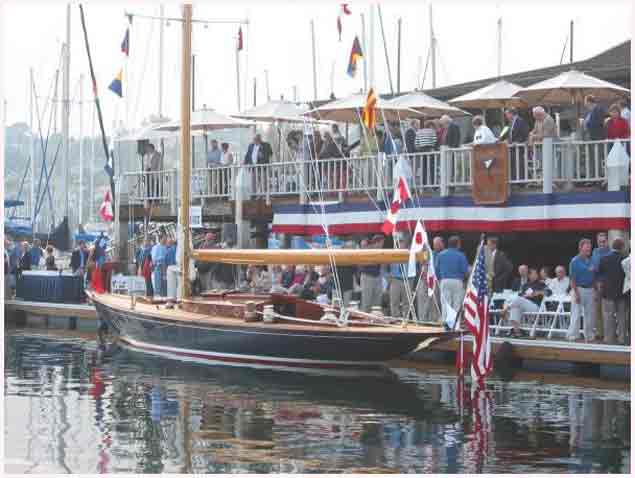 Cotton Blossom II after restoration by Johnny Smullen
Cotton Blossom II after restoration by Johnny Smullen
Inspired by Jack Brennan and other master craftsmen, Johnny has gone on to become a shipwright of such skill from his base in San Diego, California, that he in turn inspires others, one of his most famous projects being the complete restoration of the 49ft Q Class sloop Cotton Blossom II of 1925 vintage.
When a complete restoration is contemplated, Johnny doesn’t mess about. The word is that when he and Dennis turned up to finalise the deal on Cotton Blossom and bring her back to San Diego, they found the previous owners sorry enough to see her go, and rather proud of the style in which they’d maintained her. But after they’d gone to sort the details with the new owner, they went to take a last look at the boat. It’s said they found that Johnny had already delivered his opinion on the existing rig by cutting the shrouds and stays at the deck with bolt-croppers, and cutting the old mast off at deck level with a chainsaw.
Maybe that’s an apocryphal Johnny Smullen from taking delivery of another boat. Yet when you see Cotton Blossom in her restored form, it’s clear what Johnny says should indeed be Holy Writ. This is a project of world standard. But what’s even more remarkable is that despite everything the Sailing Boot Camp at the NYC might have inflicted on him all those year ago, Johnny’s love of boats and sailing is such that he has his own personal sweet classic, the lovely 36ft International One Design Altair. She’s sailed as often as possible, and though he can’t make it back to Dun Laoghaire next month for the Golden Jubilee as there’s very major project under way, Altair will be racing with the San Diego classics under the National Yacht Club burgee.
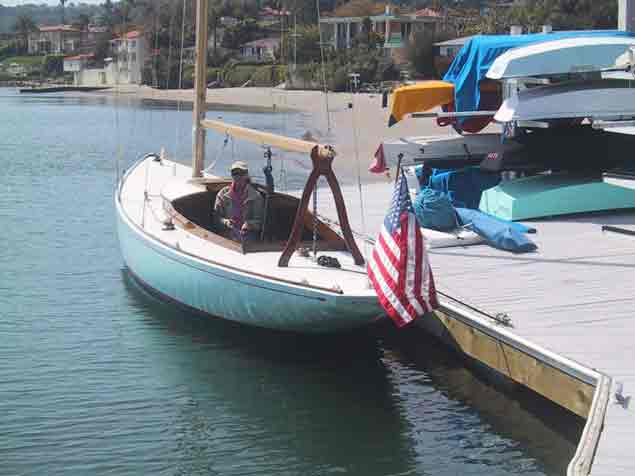 Johnny Smullen’s own pet boat Altair reveals his abiding love of sailing.
Johnny Smullen’s own pet boat Altair reveals his abiding love of sailing.
John Lavery’s father Arthur was another of those pioneering Optimist dads back in the late 1960s, and John and his sister Vivienne were both in that first batch of trainee sailors. He ended up winning championships in more classes then you could quickly count, but the peak of it all came in September 1995 when he and David O’Brien of this parish won the Fireball Worlds in Dublin Bay.
In fact, the graduates from 50 years of a junior training programme at the National YC can be found in successful positions in many boat classes in many places, but it is the club’s outgoing attitude to those who wish to learn to sail which deservedly provided its most outstanding success. A long time ago a Mrs MacAleavey, a widow with no sailing connections, was looking for a club which would make her increasingly boat-mad daughter Cathy – who had recently bought a clapped-out 420 – feel encouraged in any way to learn to sail. Despite the fact that it was still in process of recovering from a fire in the clubhouse, the NYC showed itself the most welcoming along the Dun Laoghaire waterfront, so much so that Mrs McAleavey felt sufficiently encouraged to buy her daughter a new 420, and that in turn led on eventually to Cathy representing Ireland in the women’s 470 in the 1988 Olympics.
The three children she had with husband Con Murphy went on to get their introduction to sailing through the National YC’s junior programme, and daughter Annalise emerged with the talent and the burning ambition which resulted in a heart-breaking fourth at the 2012 Olympics in the Women’s Laser Radial when a medal had seemid almost certainly within her grasp. But memories of that were entirely laid to rest with the Silver Medal in the 2016 Olympics Rio after a difficult final race in which the lone sailor seemed to stay as cool as you please, while the nation at home watched with bated breath.
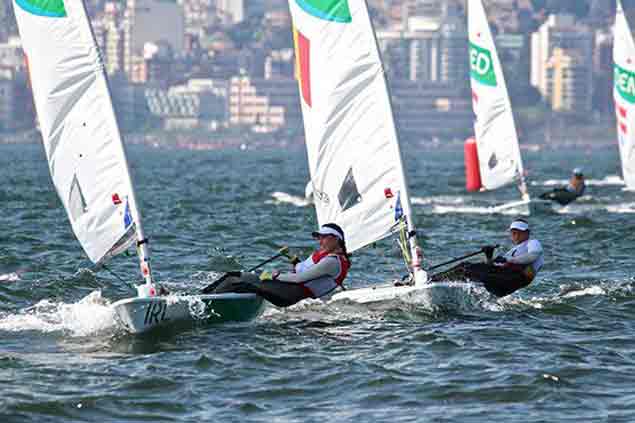 The medal-winning moment as Annalise Murphy crosses the finish line in Rio to win Silver.
The medal-winning moment as Annalise Murphy crosses the finish line in Rio to win Silver.
That it was ultimately a very personal achievement is something respected by her club, and they claim to have done nothing more than provide the first steps on the pathway, and a general spirit of encouragement. But nevertheless the success is all of a piece with the Golden Jubilee which will be celebrated on May 20th, and Carmel Winkelmann continues in her mission of providing a background of training for young sailors of all types, whether they aim only to be a competitive club sailor, or whether they aim for the ultimate heights.
Thus one of her projects in recent years was to find real support for young Finn Lynch, who had reached that difficult stage of being a top junior sailor, yet still had to find his feet as an adult. Thanks to support raised by Carmel, he became Ireland’s representative in the Men’s Lasers at Rio despite going through the final stages of the selection with a training injury recovery problem which may have had an adverse effect on his performance in as the youngest sailor in Rio, aged just 20.
Whether or not he would have been better off not being in Rio at all is neither here nor there. When you’re 20, four years can seem an appallingly long time. The Tokyo Olympics in 2020 must have seeemed aeons away for a young sailor who had shown many flashes of real talent. It was better for him to be in Rio while learning a lot, rather than kicking his heels in frustration in some dead end. And when he needed material help to see through the campaign, it was Carmel Winkelmann who was there to make to ensure that support was available. That will be something else for celebration on May 20th.
 Carmel Winkelmann and Finn Lynch at the National Yacht Club, June 2016. Photo W M Nixon
Carmel Winkelmann and Finn Lynch at the National Yacht Club, June 2016. Photo W M Nixon
Time was when the Dun Laoghaire to Dingle Race was promoted as a handy way to position your little old cruiser in West Kerry to be nicely placed to make her way in gentle hops back to her home port on the south or east coast, ambling in leisurely stages along one of the finest cruising grounds in the world writes W M Nixon.
It was envisaged primarily as a sort of enlarged club race, the club setting the tone being the National Yacht Club in Dun Laoghaire. There, enthusiastic members and Dingle race plotters Martin Crotty, Peter Cullen and Brian Barry added a further attraction when promoting the first race, as it drew nearer in 1993, by suggesting that real dyed-in-the wool cruising types might find the race of interest if they were thinking of continuing with a clockwise cruise on round Ireland.
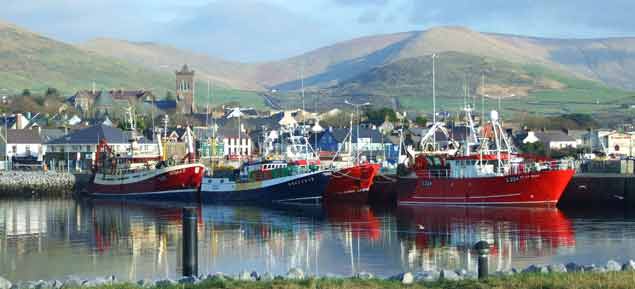 Dingle Harbour makes for an attractive destination...
Dingle Harbour makes for an attractive destination...
 …while its marina is enticing for cruisers and racers alike
…while its marina is enticing for cruisers and racers alike
Lovely idea. But so far as I know – though it’s very much hoped that I’ll be rapidly informed otherwise – it is this goggle-eyed wordsmith focused on his ancient computer screen who is still the only cruiser-racer skipper who has completed the Dun Laoghaire to Dingle Race, and then cruised on round Ireland.
We did it in handy stages, leaving the boat in Dingle for ten days after the race was completed to return home to the word-production coalface, then going on to leave her on a mooring we’d laid at Arbear at the head of Clifden Bay after we’d cruised the Aran Islands and Connemara in detail, followed by another return home for the manufacture of merchandisable verbiage. Then the third stage was home to Howth round the top, with Donegal doing its best to rival Kerry for dramatic scenery.
However, that was all a very long time ago. In fact, it was so long ago it was the first time I’d sailed with a proper pair of Dubarry Shamrock Goretex boots. I’d previously had an experimental leaky pair from a different manufacturer with which I’d persisted for years, so I can still remember the sheer joy of dry warm feet whatever the weather after the genuine Dubarrys had been deployed.
But enough of such ramblings - even if it does serve to remind us of the way the Dun Laoghaire to Dingle Race has become a much-loved part of our sailing world. And as for the reason for people not cruising on round Ireland when being in Dingle leaves them so handily placed for continuing the circuit - the answer is simple. The fact is that the course of almost 300 miles has taken them as swiftly as possible past some of the most glorious cruising places in Ireland, and the only way the skipper can keep his shipmates plugging on is by swearing on all that is holy that they’ll cruise gently back the same way in a much more civilised style.
In such circumstances, you’re whistling against the wind in trying to sell the coast of Connacht as the more interesting way to get home. Yet from an early stage, even the notion of the Dingle dash as having a strong cruising orientation hasn’t really held up for a significant part of the entry. People go into it with every intention of winning, and the talk of conveniently positioning the boat for a spot of cruising in Kerry and West Cork has only been smoke and mirrors.
![]() The Yellowbrick record of the Dun Laoghaire-Dingle Race in 2015. Sometimes the fleet has been even more widely spread than this
The Yellowbrick record of the Dun Laoghaire-Dingle Race in 2015. Sometimes the fleet has been even more widely spread than this
The pace was set from the off in 1993, when the winner was Richard Burrows’ Sigma 36 Black Pepper. In subsequent years, she was cruised to Greenland and other Godforsaken spots in the ownership of fellow Malahide sailor Peter Killen, so Black Pepper has a boat history which must make her the best-used Sigma 36 ever. Certainly for the Dingle dash of 1993, skipper Burrows shipped aboard the formidable talents of Peter Wilson and Robert Dix as the main occupants of the driving seat, and Black Pepper had a wellnigh perfect race.
That said, at the riotous prize-giving afterwards – the Dingle prize-giving is always riotous, just relax and enjoy it – Black Pepper’s skipper gave a wildly funny speech which he rounded out by presenting Robert Dix with the Golden Blanket Award. As to what was meant by that I haven’t a clue, so you’ll have to ask Dixie himself. But as he has been winning major awards of every kind since 1970 when he became the youngest ever Helmsmans Champion, the Golden Blanket goes well in his trophy cabinet.
With the first race off to such a humdinger inauguration, the vision of the founders had been justified. Well, perhaps “vision” is overstating it. At this week’s launching of the 2017 staging, which will be on June 14th, longtime organiser Martin Crotty revealed that the idea of the Dingle Race came about almost by misadventure.
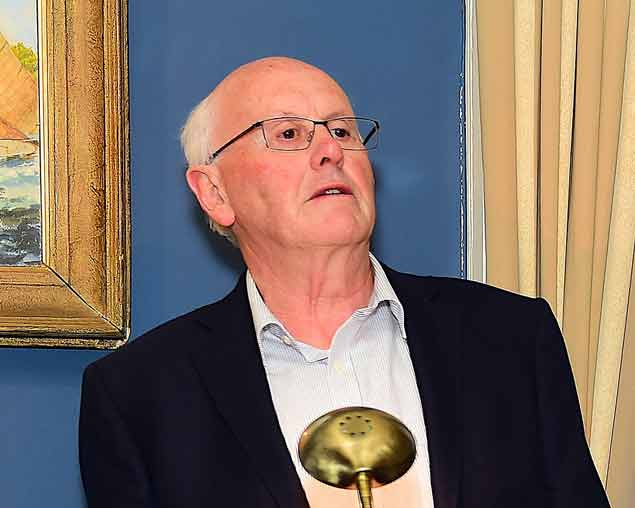 The founding Dingle Race organiser Martin Crotty reminiscing about the early days in 1993 at this week’s reception in the National Yacht Club. Photo Michael Chester
The founding Dingle Race organiser Martin Crotty reminiscing about the early days in 1993 at this week’s reception in the National Yacht Club. Photo Michael Chester

He and fellow owner Peter Cullen had been doing the 1992 Round Ireland Race with their hefty Sigma 41 Koala, and in slugging up the west coast into a particularly unpleasant northerly (I remember that one too), their mainsail went into several pieces on the latitude of Loop Head, so they retired and ran back to Dingle, a place they didn’t know at all.
They got to know it very well indeed over the next day or two, and the hospitality the little West Kerry port meted out to them – with the Dingle Skellig Hotel more or less providing open house – soon got them thinking that a race there rather than sailing all the way round the Emerald Isle would be an interesting alternative in the years when the biennial Round Ireland Race from Wicklow was not being staged.
Such ideas seem marvellous over a pint or three as midnight draws on, then fade from the memory. But there was some special chemistry already at work between the can-do Dun Laoghaire sailors and the maritime-minded folk of Dingle. Perhaps it’s because both ports think they’re the hub of the universe…… Whatever the secret ingredient, by 1993 in Dingle Harbour, Master Brian Farrell was ready to welcome the fleet, a new marina was in the making, and Dingle was on the cusp of an entirely new era.
 Dingle in the far west of Kerry has formed strong links with Dun Laoghaire in Dublin Bay, yet the two places could not be more different.
Dingle in the far west of Kerry has formed strong links with Dun Laoghaire in Dublin Bay, yet the two places could not be more different.
As for the Dun Laoghaire to Dingle Race, we knew it was fully part of the scheme of things by 1995, as Denis Doyle turned up to compete with Moonduster. Once that happens, you know your race has arrived, and “The Doyler and The Duster” were honoured participants for many years, encouraging some very substantial boats to subsequently take part, with new heights being reached in 2009 when Michael Cotter’s handsome 78ft Whisper brought a touch of global glamour and a new record, though she missed the magic 24 hours by 43 minutes and 45 seconds.
As each race succeeded its predecessor, a bonus emerged when it was acknowledged that the Dun Laoghaire to Dingle would count as a qualifier for the Fastnet Race, which would as usual be staged about eight weeks later. By this stage the race had so much going for it that it seemed impervious to setback, but like everything else in Irish life, it went through diminished times during the recessionary years.
 When “The Doyler and The Duster” (Denis Doyle and Moonduster) became involved from 1995 onwards, the Dun Laoghaire to Dingle race was made. This is a page from the August 199 Afloat magazine, with Moonduster much in evidence in the race report. The winner that year was Donal Morrissey’s GK34 Joggernaut from Galway, and in those days the start was in Dun Laoghaire Harbour.
When “The Doyler and The Duster” (Denis Doyle and Moonduster) became involved from 1995 onwards, the Dun Laoghaire to Dingle race was made. This is a page from the August 199 Afloat magazine, with Moonduster much in evidence in the race report. The winner that year was Donal Morrissey’s GK34 Joggernaut from Galway, and in those days the start was in Dun Laoghaire Harbour.
But then came 2015, and the numbers were back up, and then some. Having seen his pet project through times good and bad, Martin Crotty had indicated that this 12th Dun Laoghaire to Dingle Race would be the last he would personally administer, but already a strong successor was being briefed in the person of Adam Winkelmann. And in the 2015 race he had a vintage familiarisation to observe how it all worked, though as his mother Carmel was for many years one of the time-keepers, he started from a position of inside knowledge.
Over the years, the Dingle Skellig Hotel, which showed such generosity to the sea-battered crew of Koala way back in 1992 – leading to the inception of the race – has stayed on board as co-sponsor, and everyone’s longterm faith in the event was born out in 2015’s race, which was a classic. Before it, the atmosphere around the National Yacht Club was pure carnival, and while the start may have been slow, the winds soon filled in from the north and the fleet scampered down the east coast.
Out in front, the line honours battle was between Adrian Lee’s Cookson 50 Lee Overlay Partners from Dun Laoghaire and Anthony O’Leary’s Ker 40 Antix from Cork, and they went so well that for a while it looked like Antix might get the corrected time win. But holes in the wind at the Fastnet and beyond shook up the order, and by the finish it was glory day for J Boats, with the Shanahan family’s J/109 Ruth (NYC) winning by 20 minutes from her Pwllheli-based sister-ship Mojito (Peter Dunlop & Vicky Cox), the first foursome being very complete for the Johnstone brothers as the J/122 Aurelia was third and the J/109 Dear Prudence was fourth.
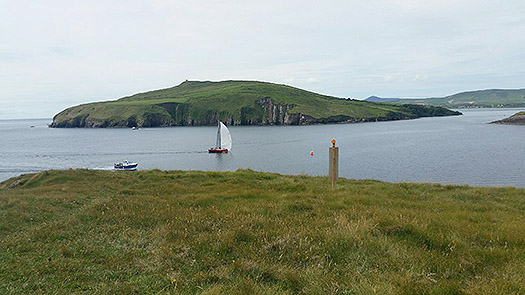 Anthony O’Leary’s Ker 40 Antix crossing the finish line at Dingle in 2015
Anthony O’Leary’s Ker 40 Antix crossing the finish line at Dingle in 2015
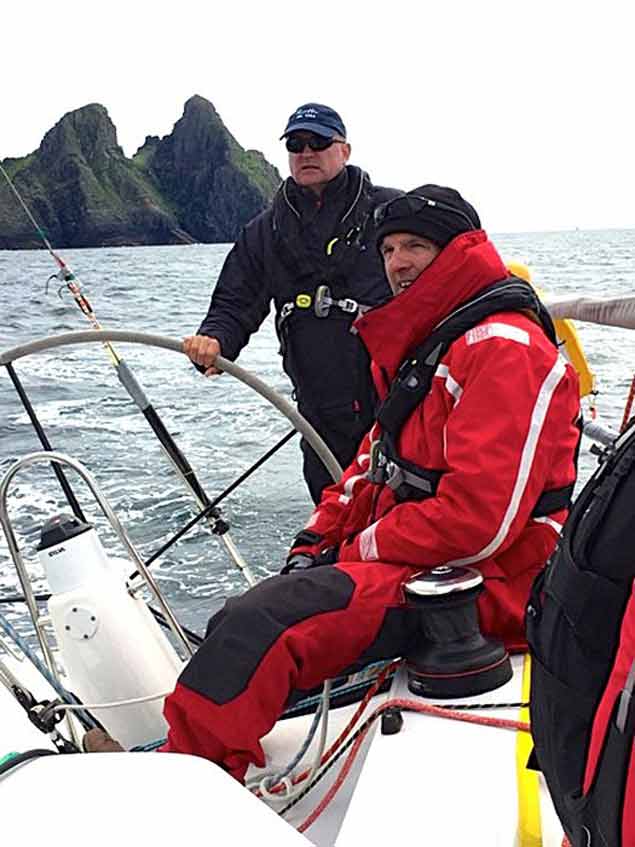 Overall 2015 winner Liam Shanahan at the helm of his J/109 Ruth with Skellig Michael put astern, and crewman Kevin Daly trimming the main for the final stage up Dingle Bay to the finish.
Overall 2015 winner Liam Shanahan at the helm of his J/109 Ruth with Skellig Michael put astern, and crewman Kevin Daly trimming the main for the final stage up Dingle Bay to the finish.
 After a rugged race, there’s nothing like an al fresco party at Dingle
After a rugged race, there’s nothing like an al fresco party at Dingle
But in a fascinating contest, almost every boat was having her day at one stage or another, and for those who were doing the race as a Fastnet qualifier, it came up trumps. Irish Offshore Sailing’s 36ft Jeanneau Desert Star may have only been in the middle of the fleet in the Dingle results, but her crew were on a learning curve and on top form by the time they did the Fastnet Race, so much so that they won overall in the 33-boat fleet making up the Sailing Schools Division, a well-earned dream result for skipper Ronan O Siochru.
So Martin Crotty handed over a prestigious event in really good order to Adam Winkelmann after all the D2D business was done and dusted in 2015, and this week’s launching reception in the National Yacht Club for what is now the Volvo Dun Laoghaire to Dingle Race was one of those gatherings which ticked so many boxes that we could get a month’s worth of Sailing on Saturdays out of it.
The heartwarming sense of continuity was palpable. Not only was Adam Winkelmann taking over the D2D from Martin Crotty, but in the host club, Ronan Beirne had been barely a wet week as the new Commodore in succession to Larry Power. To say that the speeches were in tune with the mood of the evening barely gets the flavour of it. It was a time for nostalgia, a time for relishing the present, and a time for keenly anticipating the future, with all aspects covered.
 Adam Winkelmann, chair of the Volvo Dun Laoghaire Dingle race Committee, reveals his hopes for 2017’s race and the races beyond. Photo: Michael Chester
Adam Winkelmann, chair of the Volvo Dun Laoghaire Dingle race Committee, reveals his hopes for 2017’s race and the races beyond. Photo: Michael Chester
It was Adam Winkelmann who summed it all up in a friendly presentation – he does it so painlessly that the word “speech” is way too pompous – effortlessly telling us about the new dynamic with the lineup with Volvo, the continued support from Dingle with the Dingle Skelligs Hotel joined by Crean Brewery – and the growing interest from the RORC with that club’s Janet Grosvenor – a very good friend to Irish offshore racing – planning to monitor the Volvo Dun Laoghaire to Dingle Race 2017 with a view to giving it greater recognition in the RORC’s 2019 programme.
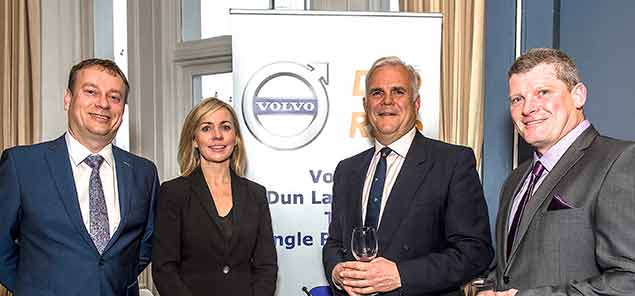 Graham Fitzgerald of the Dingle Skellig Hotel, Patricia Greene of Volvo Car Ireland, Adam Winkelmann, and Jerry O’Sullivan of Crean Brewery, Dingle. Photo Michael Chester
Graham Fitzgerald of the Dingle Skellig Hotel, Patricia Greene of Volvo Car Ireland, Adam Winkelmann, and Jerry O’Sullivan of Crean Brewery, Dingle. Photo Michael Chester
As it is, the 2017 race will start on the evening of Wednesday June 14th, which research among competitors has show is reckoned as the most user-friendly time for those fitting the race into work breaks, as it means you can definitely do a three day week, yet have every chance of making the clock-in at the workplace first thing Monday morning.
Thus the prize-giving will be on Saturday night, and it is being moved beck to the Dingle Skelligs’ sister establishment, Benners Hotel in the heart of town. As for the bigger picture, the timing also allows a useful gap before the Sovereigns Cup series starts at Kinsale on June 21sr, but while the start time will be tight for anyone who also plans to also do the ICRA Nationals at Crosshaven from Friday June 9th to Sunday June 11th, in times past we’d have reckoned that’s it a logistical challenge which is do-able, you just draw lots for the three guys who are going to take the boat to Dun Laoghaire as soon as the last race at Crosser is over.
As if that’s not enough of a challenge, Ric Morris has lately been airing a suggestion that it’s time to think seriously about an Irish National Offshore Championship based around the many events already in existence. He reckons that with the Round Ireland and the Dun Laoghaire to Dingle races alternating at the peak of this annual season-long series, we’d have an intriguing setup which has the potential to involve many boats – and he means many big time.
Certainly the imprimatur of the RORC on the Volvo Dun Laoghaire Dingle Race would give it turbo power, making it a serious points accumulator apart from being a superb race in its own right. Truly it has moved on a long way from being a handy little club-oriented event best used to position your boat in Ireland’s finest cruising ground. But we shouldn’t be surprised, when we remember that the Fastnet Race itself started in a very modest way in 1925. It was so shunned by the sailing establishment that it couldn’t get a starting line at Cowes, and had to be sent eastward out of the Solent from the start line of the Royal Victoria Yacht Club at Ryde.
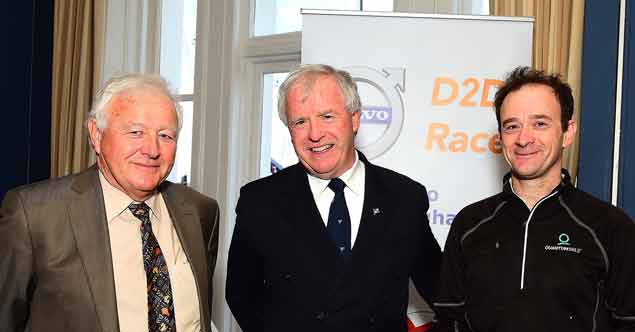 Brian Farrell, Harbour Master of Dingle when the Dun Laoghaire-Dingle race was inaugurated in 1993, Ronan Beirne the newly-elected Commodore of the National Yacht Club, and Yannick Lemonnier, who will be racing a Minitransat 650 to Dingle. Photo Michael Chester
Brian Farrell, Harbour Master of Dingle when the Dun Laoghaire-Dingle race was inaugurated in 1993, Ronan Beirne the newly-elected Commodore of the National Yacht Club, and Yannick Lemonnier, who will be racing a Minitransat 650 to Dingle. Photo Michael Chester
Presumably the RORC still sends the RVYC an annual Christmas card as a token of their appreciation of that display of faith way back in 1925, now that the hugely popular Fastnet Race is started from all the glory of the Royal Yacht Squadron line at Cowes.
And as for the Dun Laoghaire-Dingle Race in all its manifestations, while it has always been comfortably under the imprimatur of the National Yacht Club in Dun Laoghaire, the developing positive attitude towards sailing at official levels in Dun Laoghaire/Rathdown was underlined by the official presence at Tuesday’s gathering of Councillor Cormac Devlin, Cathaoirleach of Dun Laoghaire/Rathdown County Council.
But while the new turbo power of the Volvo Dun Laoghaire to Dingle Race was quietly in evidence at the party in the National YC this week, it was good to meet up with old friends from Dingle from the earliest days, particularly the former Harbour Master Brian Farrell whose enthusiasm for his job always went way beyond the call of duty.
There too were Brian Barry and Peter Cullen, both of whom did so much to put the show on the road and keep it there through times good and bad. But it was appropriate that also present was the one and only Yannick Lemonnier, who did the race in the two-handed division in 2015 (he was second to Howth’s Colm Buckley and Simon Knowles) but in 2017 will be doing it in a new special division which has been encouraged into the fray by the National’s Sailing Manager Olivier Prouveur.
Yes indeed – the Volvo Dun Laoghaire to Dingle race will be providing a start for Mini 650 boats, and Yannick Lemonnier will be right in the thick of it all. They’ll get a separate prize and won’t be in the IRC Division, but it’s a new twist in a race which, in 2017, will also have a new old twist.
 David Thomas, MD of Volvo Car Ireland, with Emma O’Carroll, also of Volvo Car Ireland, and Darryl Hughes, owner-skipper of Maybird, the first gaff-rigged entrant in the Dingle Race. Photo Michael Chester
David Thomas, MD of Volvo Car Ireland, with Emma O’Carroll, also of Volvo Car Ireland, and Darryl Hughes, owner-skipper of Maybird, the first gaff-rigged entrant in the Dingle Race. Photo Michael Chester
For no-one has any recollection of the Dun Laoghaire to Dingle Race ever having a gaff-rigged entry in its 24 years. Yet the madly enthusiastic Darryl Hughes has entered his beautifully-restored 1937 Tyrrell-built 43ft gaff ketch Maybird. He knows he’ll be doing quite well to make it to Dingle in time for the prize giving. And then he’ll have to think of further schedules, as he is also entered for the Classics Division in the Volvo Dun Laoghaire Regatta from July 9th to 12th. But in the National this week this week he was able to assure everyone that Maybird is already well n the way to being race ready. Sure hadn’t he and his mates scrubbed her and anti-fouled her – including a fresh boot-top – all on the one Spring tide at Poolbeg a couple of weeks ago? So the count-down is already well under way for the turbo-powered Volvo Dun Laoghaire-Dingle Race 2017.
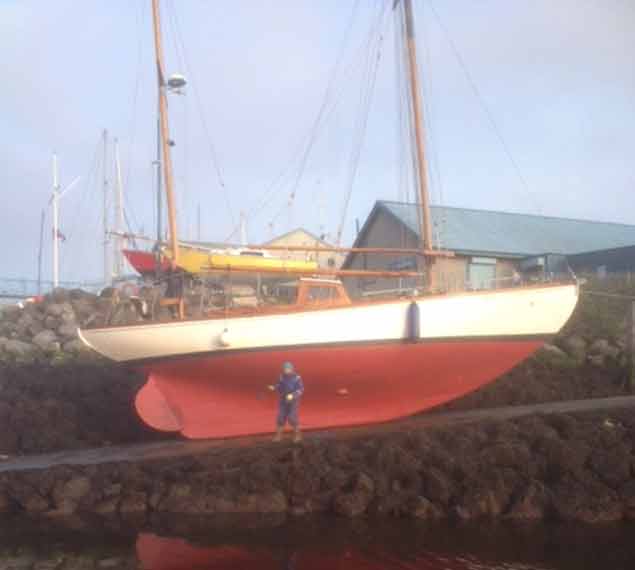 Race preparation. Maybird gets completely re-antifouled and with a fresh boot-top a fortnight ago, all in one tide at Poolbeg
Race preparation. Maybird gets completely re-antifouled and with a fresh boot-top a fortnight ago, all in one tide at Poolbeg
National Yacht Club Elects Ronan Beirne as Commodore
The National Yacht Club has elected Ronan Beirne as Commodore at last week's agm in Dun Laoghaire. The Flying Fifteen sailor and Irish Cruising Club member will have Martin McCarthy as Vice–Commodore and Susan Spain as Rear.
The Honorary Secretary of the waterfront club is Peter Sherry and the Honorary Treasurer is Conor O’Regan.
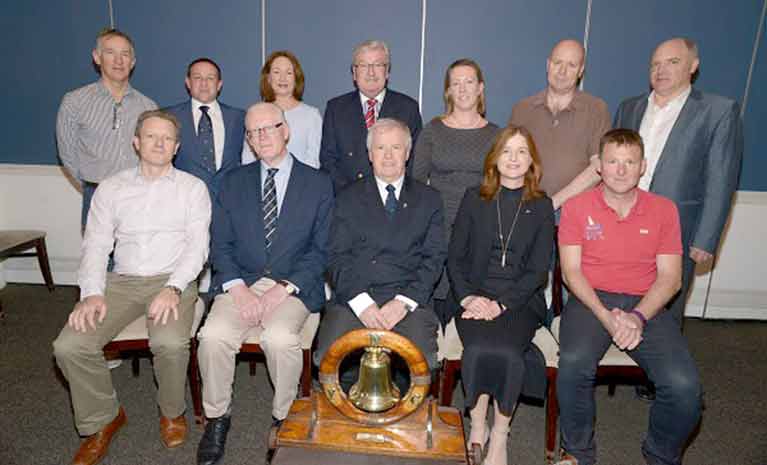 The 2017 National Yacht Club Flag Officers and Committee
The 2017 National Yacht Club Flag Officers and Committee
Other members of the NYC committee are:
Sailing Secretary: Peter Murphy
Boathouse Captain: Cillian Meldon
Junior Section Secretary: Fiona Staunton
General Committee: Michéle Halpenny
General Committee: Helen Cooney
General Committee: John McNeilly
General Committee: Alan Turner
General Committee: Chris Doorly
General Committee: Peter Doran
The National Yacht Club looks set to gain Royal Ocean Racing Club recognition for its mini–offshore Dun Laoghaire Dingle race as David O'Brien reports in the Irish Times Sailing Column this morning.
The Dun Laoghaire Dingle application is well timed because RORC Commodore Michael Boyd says the London–based club is keen to encourage RORC racing across the UK, not just Channel races.
The June 14th race – first hosted by the NYC and County Kerry’s Dingle Sailing Club in 1993 – is working closely with Dublin Bay Sailing Club (DBSC) and the Irish Sea Offshore Racing Association (ISORA) to develop the “mini-offshore” into an international race.
Incoming race chairman Adam Winkelmann is adding extra spice by adding a new title sponsor and recruiting a French Mini–Transat fleet.
RORC will assess this Volvo-sponsored edition of the race with a view to adding the race to its points series in 2019.
Read the full story in the Irish Times here and more on this year's D2D race here
Volvo Dun Laoghaire to Dingle Race (D2D) race organisers at the National Yacht Club have published five compelling reasons why June's race measures up to be the 'perfect family friendly offshore race'. The club is keen to build on the ethos and tradition of the race.
- 1. At almost 300 miles it is the perfect length typically taking the whole fleet something between 30 and 50 hours to get to Dingle in the beautful surrounds of Kerry.
- 2. It is mostly along the coast rather than a crossing which contrubites to safety and enjoyment.
- 3. It mixes both racing boats and cruising boats with prizes for both.
- 4. It is in the same year as the Fastnet race, thereby providing a perfect training ground for crew and boat as testified to by RORC (the Royal Ocean Racing Club) the Fastnet Race organisers. It also forms part of the ISORA (Irish Sea Offshore Racing Association) season.
- 5. It is a great feeder race. Having arrived in Kerry the participants can choose to cruise the amazingly beatiful area of Kerry and West Cork or head back to Kinsale for Sovereigns Week.
On Tuesday, (April 4) at the official launch in the NYC, the club announces new race sponsors and associates under new race Chairman, Adam Winkelmann.
As if to emphasise this family racing aspect, the last race winner, from 2015 was a dedicated family boat from the host club. Liam Shanahan Jnr skippered his J109 Ruth to victory ahead of Welsh yacht Mojito, (J/109) Peter Dunlop & Vicky Cox, Pwllheli SC. It was a result that enabled Shanahan to lift the Irish Sailor of the Year Award for 2015. The Shanahan entry intends to defend her title and is among the first race entries along another Dun Laoghaire family boat, Aurelia, a J/122, Chris & Patanne Power Smith, from the Royal St George YC who was third in 2015. Read about Liam Shanahan's family sailing values here.
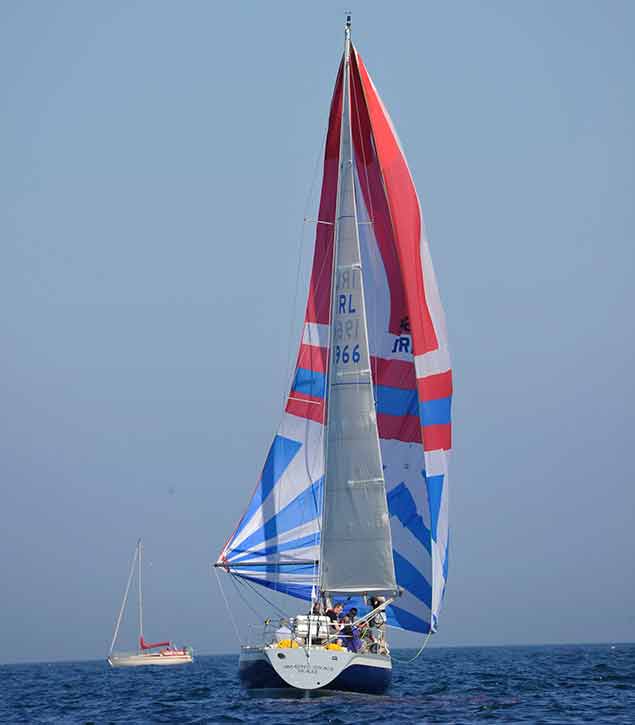 Kerry yacht Amazing Grace (Brian O'Sullivan) clinched the light air 2013 Dun Laoghaire Dingle race title... Photo: Michael Chester
Kerry yacht Amazing Grace (Brian O'Sullivan) clinched the light air 2013 Dun Laoghaire Dingle race title... Photo: Michael Chester
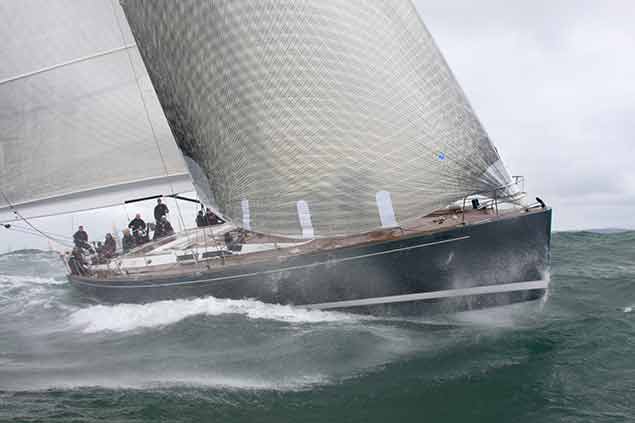 ...but not all editions have been light air affairs. In 2009, competitors got a wild ride to Dingle when winds gusted to 30–knots for the start off Dun Laoghaire and Michael Cotter's Whisper (above) set a new course record. Photo: Afloat.ie
...but not all editions have been light air affairs. In 2009, competitors got a wild ride to Dingle when winds gusted to 30–knots for the start off Dun Laoghaire and Michael Cotter's Whisper (above) set a new course record. Photo: Afloat.ie
Winkelmann is confident of a buoyant entry to match 2015's 30–boat fleet but makes the point entry is still wide open and boats from all ports are very welcome.
The 2017 race starts in Dun Laoghaire from the National Yacht Club on Wednesday June 14th at 19.00 hours. The prizegiving party will take place in Dingle in Benners Hotel on June 17th evening. The organisers expect between 30 and 35 boats across 3 classes, including the mini-transat class racing for the first time with some well know international sailors.
Winkelmann adds “It is great to have Volvo on board to compliment our long term partners in Dingle and in particular the Dingle Skellig Hotel Group. We have been encouraged by the growing interest in the race both at local and international level.” We see the race as the perfect mini offshore.
In addition, the race also has an association with Crean’s Brewery and Billy Naughton Cars of Tralee. Since its inception in 1984 this race has always thrived on the wonderful co-operation between the National Yacht Club in Dun Laoghaire and those local businesses in Dingle that provide a great welcome and hospitality at the finishing destination.
Volvo Car Ireland already firmly established as the brand partner for sailing in Ireland have added the D2D race to the Volvo Dun Laoghaire Regatta and the other major events on the sailing calender in Ireland. David Thomas, recently appointed new Managing Director for Volvo Car Ireland commented that “We are delighted to support this race as we see it as a perfect fit with our global commitment to sailing which extends from the Volvo Ocean Race right down to these important grass roots events in Ireland”.
Read more: Dun Laoghaire to Dingle Race
Ongoing technical issues with the Volvo Dun Laoghaire Regatta website this week is giving sailors an extra opportunity to avail of a discounted early bird entry fee that was due to close today.
Organisers issued an apology via social media this morning adding two weeks to the entry deadline. VDLR say: 'Apologies for the chronic website problems this week - because of this we're EXTENDING the #EarlyBird entry deadline to 13th April'.
In the meantime, while the issues with the site are resolved, an entry list at March 20 is here. And the latest Dun Laoghaire Regatta news is on our dedicated section on Afloat.ie here
National Yacht Club Achievements in 2016 Include Cruising, Offshore, One Design & Dinghy Sailing Success
Dun Laoghaire's National Yacht Club gathered on Saturday to salute top club achievements from 2016. Ten annual awards for outstanding sailing were presented ranging from cruising endeavours to Olympic campaigns. There is no surprise that club member Annalise Murphy topped the awards with her Olympic Silver Medal being the defining moment of the Irish sailing year.
In cruising, The Township Cup went to Jim Gorman for his cruise to Norway. Marcus Higgins was awarded The Muglins Cup for his adventurous cruise on his Vega 27 thorugh the Canal du Midi to Sardinia.
In the offshore racing category, Brian and John Hall were awarded the Boyne Regatta Cup for their victory in the Scottish Series.
In one design racing, The O'Leary Cup went to Mick Leahy and John Power for their performance in the Beneteau 31.7 Levante in both DBSC and regattas in 2016.
View a slide show of the 2016 recipients by Joe Fallon below:
For the summer of 2017 at least, it looks as though Dun Laoghaire Harbour is going to remain free of the threat of the installation of a new liner berth. W M Nixon reckons this provides a unique opportunity for town and harbour to come together as they may have done once upon a time, but have failed to replicate for many years. He provides the background, and makes some suggestions.
The trouble with Dun Laoghaire is that there’s nowhere else quite like it. There isn’t really a truly comparable totally artificial harbour anywhere else on this scale set on the edge of a city, in the midst of an area of general affluence and recreational expectations. It is arguably unique. Nowhere in the world is there a similar setup from which those who hope to manage Dun Laoghaire Harbour effectively might learn lessons on how to make a viable proposition of their port and its future.
Although the original asylum harbour was built by engineer John Rennie and others in majestic style, at the time it had only one simple purpose – to provide shelter for unwieldy sailing ships when Dublin Bay was storm-beset and Dublin Port with its very shallow bar entrance was inaccessible.
The original plans show a sublime indifference to the existence of the little old harbour of Dunleary immediately to the west of the proposed location of the vast new structure. And the little port there has long since disappeared under high value property development to an extent which the early harbour planners cannot have begun to imagine.
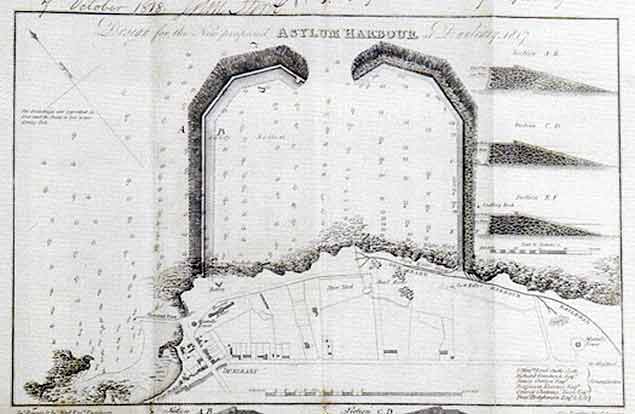 The original plan for the new harbour deliberately excluded the little old harbour of Dunleary to the west, as the new harbour was not intended to provide ship to shore access.
The original plan for the new harbour deliberately excluded the little old harbour of Dunleary to the west, as the new harbour was not intended to provide ship to shore access.
For the idea was not that this would be a port. On the contrary, it would only be a place of temporary shelter in which vessels of importance – particularly those on British government business - would be secure until conditions improved. It was not envisaged that there would be any significant shoreside contact during their short time in what very quickly became Kingstown Harbour.
For of course, no sooner was a harbour under construction, than a town began to develop beside it. It was notoriously un-planned, so much so that fifty years later a critic mocked its name of Kingstown – conferred with a Royal visit in 1821 – by pointing out that far from being a King’s town, it was rather more of a republic of selfish building anarchy.
At the beginning – which we now date to 200 years ago, with the first stone officially laid on May 31st 1817 - significant shoreside development had not been intended. As historian Hal Sisk has pointed out, at no time did the official plans include anything so basic to a proper port town such as warehouses, let alone shipyards or even boatyards. But the basic existence of the harbour in its earliest form by the late 1820s saw the first regatta being staged in 1828. Recreational sailing and the harbour have been intertwined ever since. And the irresistible growth impulse of Kingstown was underlined by the arrival of the railway from Dublin in 1834.
 The eastern part of Kingstown harbour at its Victorian high point as a ferry port. The area in the centre, immediately east of Carlisle Pier, will be used for berthing Classic and Traditional Vessels in July during the Volvo Dun Laoghaire Regatta 2017.
The eastern part of Kingstown harbour at its Victorian high point as a ferry port. The area in the centre, immediately east of Carlisle Pier, will be used for berthing Classic and Traditional Vessels in July during the Volvo Dun Laoghaire Regatta 2017.
We take that date of 1834 for granted, but in terms of world railway history, it was very early indeed. And it in turn roped Kingstown into other unplanned developments. As long as the entrance to Dublin port remained dangerously shallow, Kingstown had all the advantages for the rapid development of the cross channel ferry trade. It was all done initially on an ad hoc basis, but it worked for the ferries, while the already proven attractions of the place as an innovative recreational sailing location made it central to world sailing development by the 1860s and 1870s.
So for most of the two hundred years whose history we’ll be celebrating in July, Dun Laoghaire/Kingtown has been struggling with the fact that the basic concept of the harbour - which by its monumental and historic scale still dictates what can be done with it today – was planned with virtually no attention paid to the sea/land interface.
 Despite the restrictions on waterfront space, Kingstown Harbour had become a leading sailing centre by the latter half of the 19th century, as shown in this painting by Richard Brydges Beechey of a Royal St George YC regatta in the 1870s. Courtesy RStGYC
Despite the restrictions on waterfront space, Kingstown Harbour had become a leading sailing centre by the latter half of the 19th century, as shown in this painting by Richard Brydges Beechey of a Royal St George YC regatta in the 1870s. Courtesy RStGYC
Ideally, when the harbour was being built, at least as large an area ashore should have been set aside on the adjacent land to provide for a proper harbour town. But nothing remotely like this was done, and the railway was brought in by the easiest possible shoreside route, thereby putting another barrier between the growing town and the harbor. As a result, the town/harbour relationship has always been problematic. This is particularly so when allied to the fact that areas of conspicuous affluence are almost cheek by jowl with what seem like semi-deprived areas by comparison.
On top of all this, there’s the eternal problem of paying for the harbour’s maintenance. It was superbly built in the first place, but it would be an insult to those early engineers, and their incredibly industrious workers labouring under dangerous conditions, if we failed to maintain the harbour properly in a manner which respects its original concept, while continuing to give it validity for contemporary life.
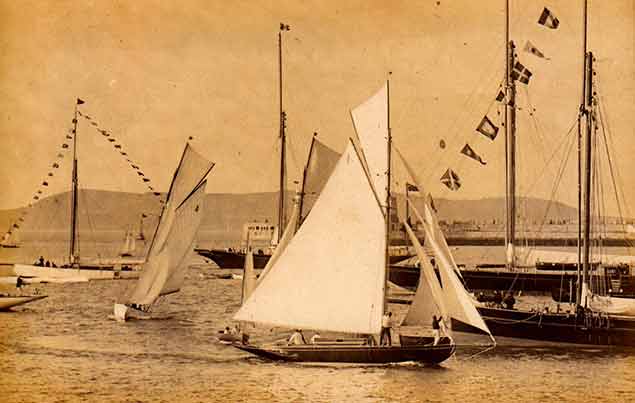 The good old days……..It is the summer of 1901, and the Viceroy Lord Dudley is finishing in-harbour after threading his course through moored yachts to take the win with his new Dublin Bay 25 Fodhla in company with some boats of the new version of the Water Wag class. In second place in the DB 25s is Nepenthe (No 4, Sir H Robinson). Both Dublin Bay 25s were built in Dun Laoghaire by J E Doyle. Photo courtesy Theo Harris
The good old days……..It is the summer of 1901, and the Viceroy Lord Dudley is finishing in-harbour after threading his course through moored yachts to take the win with his new Dublin Bay 25 Fodhla in company with some boats of the new version of the Water Wag class. In second place in the DB 25s is Nepenthe (No 4, Sir H Robinson). Both Dublin Bay 25s were built in Dun Laoghaire by J E Doyle. Photo courtesy Theo Harris
Since the ferries pulled out to re-locate entirely in Dublin Port, taking their guaranteed income stream with them, the struggle has gone on between those who wish to develop any potential the harbour might have for a cruise-liner port of call, and those who feel it should be seen more as a sort of maritime version of the Phoenix Park. They envisage it as a vast breathing space, ultimately maintained by public funds if there’s a shortfall between the income generated by recreational use, and the routine maintenance and administration expenses.
But for the moment, any further development has been postponed awaiting a court case. In it, the point is to be made that making the harbour accessible to functioning liners, with emission-spewing machinery working on a 24/7 basis, will have the effect of polluting the atmosphere in and around the harbour - particularly along the East Pier, the regular promenade for thousands of Dubliners in search of fresh air.
Apparently this point had not been made in the original hearings, so the result is that for the summer of 2017, Dun Laoghaire Harbour will continue as it is at present, with new areas of open sailing space available following the removal of the Stena installations.
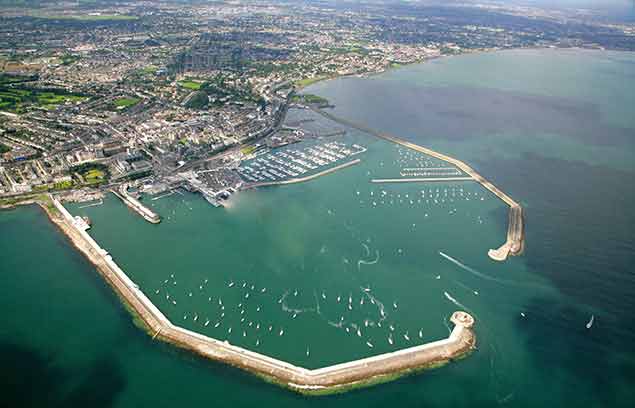 Dun Laoghaire Harbour as it is at present, offering ample space for finishing races. Photo Peter Barrow
Dun Laoghaire Harbour as it is at present, offering ample space for finishing races. Photo Peter Barrow
In the circumstances, surely this is a golden opportunity for the organisers of the Volvo Dun Laoghaire Regatta 2017 to take a look at any section of their enormous and very varied entry list, and select classes which could be given the treat of having at least one of their races finish within the harbour?
Increased ferry traffic was just one of the reasons why the racing for larger craft was obliged to take place outside the harbour. For national and international events, the obsession with committee boat starts and finishes further dictated the move seaward. In Dun Laoghaire, it meant that the connection between the town and active highly-visible sailing became more tenuous than ever.
Yet if we look back to old photos of Dun Laoghaire when it was in the full pomp of its years of Kingstown yachting glory, it was the action in the harbour which brought the whole show to life, and gave everyone a sense of involvement. So let’s hope that the powers-that-be realize that the deferring – permanently we hope – of the proposed liner berth offers an opportunity. Liners Out, Sailboats Back In – that could be the slogan for 2017.
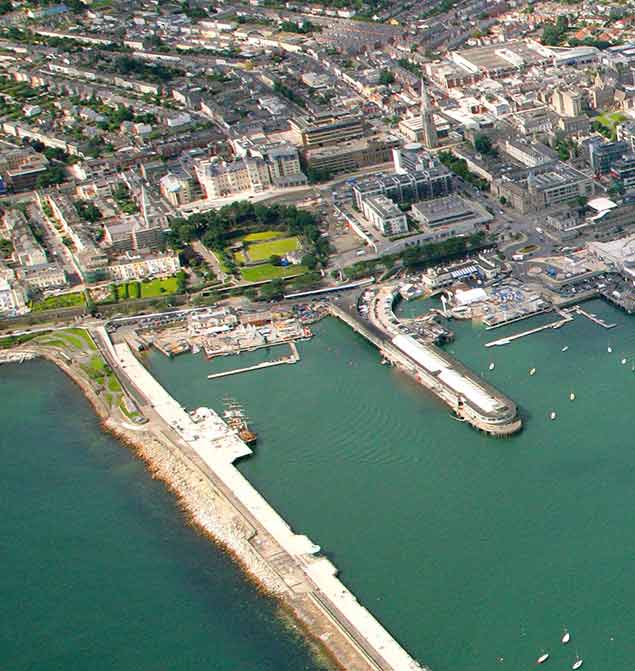 The accessible area off the National YC (photo pre-Lexicon) will provide berthing for Classics and Traditional craft Photo: Peter Barrow
The accessible area off the National YC (photo pre-Lexicon) will provide berthing for Classics and Traditional craft Photo: Peter Barrow
Of course we don’t expect that the really hot classes will agree to finish in-harbour. But there’s something about the Volvo Dun Laoghaire Regatta which attracts a significant segment of participants for whom a bit of fun is central to the sport, and indeed there are many who think that the real sport would be in having to make an in-harbour finish.
The Classics and Traditional Craft will be playing a significant role in this special year. In addition to a dedicated berth with lots of pontoon length being provided for them in the area off the National Yacht Club, the word is that on one day at least, they will have their start in the harbour, highly visible from the East Pier in the area immediately beyond the Carlisle Pier.
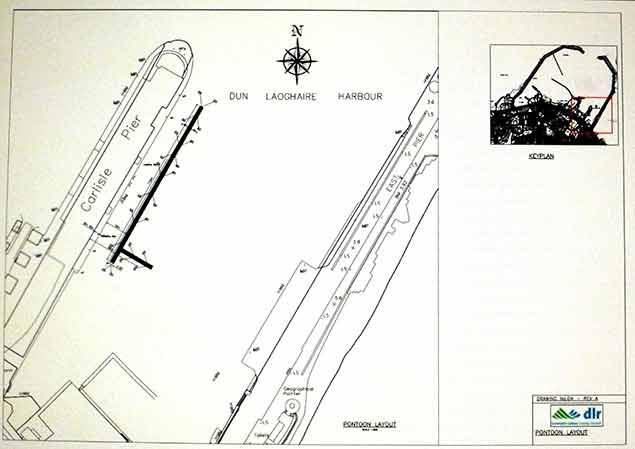 Plan of the proposed pontoon location off the National YC to berth “boats with bowsprits”.
Plan of the proposed pontoon location off the National YC to berth “boats with bowsprits”.
With boat types such as Drascombes coming as a fleet, the notion of the potential accessibility of sailing could be given an enormous boost. What could seem more approachable than the presence of Drascombe man Jack O’Keefe and his mates in friendly competition within the harbour, along with all sorts of other exotic craft such as the Shannon One Designs?
 Jack O’Keeffe’s Drascombe is usually seen in distant ports of the west… .Photo: Pierce Purcell
Jack O’Keeffe’s Drascombe is usually seen in distant ports of the west… .Photo: Pierce Purcell
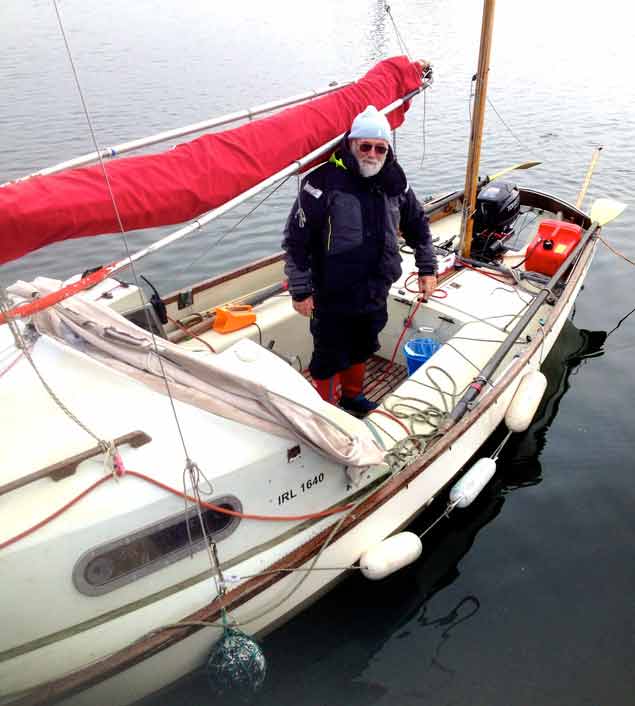 ….but in July 2017 he and his fellow enthusiasts are headed for Dun Laoghaire’s Bicentenary. Photo: Pierce PurcellNot least of such exotica will be the Water Wags, more than ever a part of Dun Laoghaire sailing and Dun Laoghaire Harbour. At this week’s launching of Volvo Dun Laoghaire Regatta ing of Volvo Dun Laoghaire Regatta 2017 in the National Maritime Museum, there was something very touching about the way that the only surviving boat of the original Water Wag class of 1887, the world’s first One Design, had been moved to the centre of the former Mariners Church. The little boat was there in pride of place as the great and the good of Irish sailing networked with each other as plans were revealed of the remarkable amount of behind-the-scenes work that goes into ensuring that this largest of all Irish sailing events runs smoothly.
….but in July 2017 he and his fellow enthusiasts are headed for Dun Laoghaire’s Bicentenary. Photo: Pierce PurcellNot least of such exotica will be the Water Wags, more than ever a part of Dun Laoghaire sailing and Dun Laoghaire Harbour. At this week’s launching of Volvo Dun Laoghaire Regatta ing of Volvo Dun Laoghaire Regatta 2017 in the National Maritime Museum, there was something very touching about the way that the only surviving boat of the original Water Wag class of 1887, the world’s first One Design, had been moved to the centre of the former Mariners Church. The little boat was there in pride of place as the great and the good of Irish sailing networked with each other as plans were revealed of the remarkable amount of behind-the-scenes work that goes into ensuring that this largest of all Irish sailing events runs smoothly.
In the 1890s, there must more than a hundred of these little boats in and around the Greater Dublin area. Even Erskine Childers, with part of the summer of 1894 unfilled in his plans, arranged to have one carted up into the Wicklow Hills to the mountain lake of Lough Dan near the house of his mother’s family, so that he could go sailing when the mood took him.
Yet with the new larger boats introduced in 1900, the little old double-enders just faded away. Fortunately, someone noticed that an odd-looking little canoe-sterned dinghy with a centreplate case on the beach at Malahide was one of the original Water Wags. She was being used for the occasional fishing trip, and it had been a long time since the centreplate had been used for sailing.
She was saved in the nick of time, and is now kept fully rigged in the Maritime Museum. But as the Wag Class historian Vincent Delany assured me at the Volvo reception, she really is absolutely the only surviving original example of a boat which was once so numerous, and fundamental to the global development of sailing.
 The original Water Wags of 1887, the world’s first One Design class. Despite being numerous in the 1890s, the original boat on display in the National Maritime Museum in Dun Laoghaire is now thought to be the only survivor of this historic type.
The original Water Wags of 1887, the world’s first One Design class. Despite being numerous in the 1890s, the original boat on display in the National Maritime Museum in Dun Laoghaire is now thought to be the only survivor of this historic type.
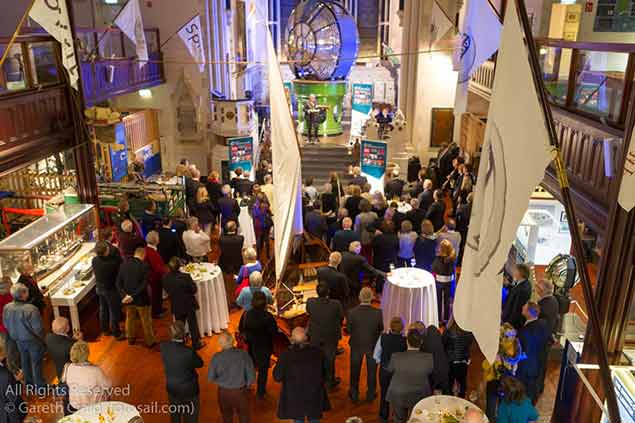 At the heart of things. The sole surviving Dublin Bay Water Wag of 1887 in the midst of the Volvo Dun Laoghaire Regatta 2017 launch reception in the National Maritime Museum on Wednesday night.
At the heart of things. The sole surviving Dublin Bay Water Wag of 1887 in the midst of the Volvo Dun Laoghaire Regatta 2017 launch reception in the National Maritime Museum on Wednesday night.
Dun Laoghaire Ready to Host Ireland’s Biggest Sailing Fixture
The 2017 Volvo Dun Laoghaire Regatta (VDLR) which is now established as the biggest sailing event in Ireland was launched this evening at the Maritime Museum in Dun Laoghaire. This biennial fixture which is organised by the four Dun Laoghaire waterfront yacht clubs (the Dun Laoghaire Motor Yacht Club (DMYC), the National Yacht Club (NYC), the Royal Irish Yacht Club (RIYC) and the Royal St George Yacht Club (RSGYC) will take place across four days in early July and attracts yachts from all four coasts of Ireland and from England, Scotland, Wales, Northern Ireland and the Isle of Man, and more locally from all the four Dun Laoghaire based yacht clubs.
Speaking at the launch event, David Lovegrove, President, Irish Sailing Association (ISA) said “The VDLR is now firmly established in Ireland’s major sporting calendar and is the biggest participant sporting event in the country, after the city marathons. We are also proud that the VDLR continues to grow and build upon Ireland's international reputation as a quality sports and sailing destination and cements Ireland's reputation as a location for a major international regatta. In addition, local area businesses will benefit considerably from the influx of visitors as they enjoy the superb sailing action in Dublin Bay and a fantastic array of family oriented activities that have been set up on shore.”
The key classes of yachts that will attract the most attention and competition during the Regatta will be the IRC Class 0, Class 1, Class 2, Class 3 and the IRC Offshore Class, who all, already have strong noteworthy entries. In addition, other ‘one design’ classes will include the Beneteau 31.7s, Beneteau 211, Sigma 33, Ruffian 23s, Dragon, RS Elite and the Shipman 28. The dinghy classes will include the GP14, Wayfarer, Squib, Mermaid, Flying Fifteen, Fireball, and single-handed Lasers and Moths.
Most notably this year there will be a Classics division in VDLR 2017 comprising a ‘Kingstown 200’ Anniversary Cup as part of the Dun Laoghaire Harbour Bicentenary Festival from July 6th to 9th 2017.
A monument on the Dún Laoghaire sea front commemorates the first stone of the eastern pier laid by his Excellency Charles Earl Whitworth Lord Lieutenant General and General Governor of Ireland on 31st May 1817, and the visit of King George IV in 1821 (Asylum Harbour of Dunleary was named Kingstown in 1821 and renamed Dun Laoghaire in 1920).
Also speaking at the launch event, Tim Goodbody, Chairman, VDLR 2017 said “The VDLR owes its prominence in European sailing events to a number of factors. One of the core attributes to attracting so many entrants is that it is one of the least expensive sailing events in Europe, thanks to generous sponsorship and support, so providing great value for money for all in the lovely waters of Dublin Bay” .
We also have more than 300 volunteers who give their time and energy to ensure the regatta runs smoothly, as well as the active cooperation of local area businesses and the Dun Laoghaire-Rathdown County Council. And of course the support from the thousands of visitors who come to watch the spectacle and take part in all the family oriented activities in and around Dun Laoghaire.”
“In addition the Regatta brings a significant amount to the local economy. Using the Irish tourism multiplier, the average expenditure per competitor will be €60 per day which for 2,500 competitors will be €150,000 per day and €600,000 for the four day event” added Tim Goodbody.
The VDLR is kindly supported by
• Volvo Car Ireland in partnership with Spirit Motor Group (Title sponsor)
• Dun Laoghaire Rathdown County Council
• Dun Laoghaire Harbour Company
• Failte Ireland
• Collen Construction – New Sponsor
• Helly Hansen
• Royal Marine Hotel
• Bretzel Bakery
• Dubarry


























